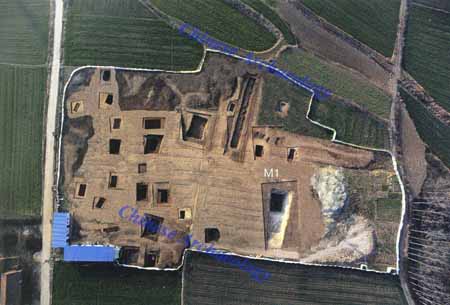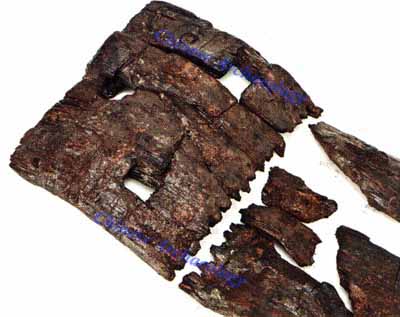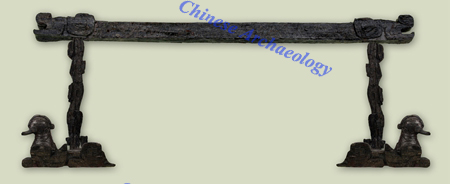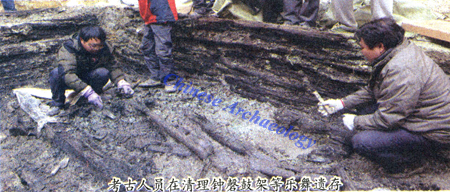New Music Archaeological Discovery Found in Guojiamiao, Zaoyang, Hubei Province
From:Chinese Archaeology NetWriter:Date:2015-06-04
In January of 2015, a large set of ritual and musical remains from about 2700 years ago were found in Guojiamiao cemetery, the tombs of Zeng state in Zaoyang, Hubei province, which brought new harvests to Chinese musical archaeology.Guojiamiao cemetery is located in Dongzhaohu Village, Wudian Town, Zaoyang City, with an area of 1,200,000 square meters, which is divided into Guojiamiao Tomb Area and Caomenwan Tomb Area. In 2002, a suspected “Zeng Baiqi” monarch tomb was found in Guojiamiao Tomb Area. In October of 2014, the excavation of Caomenwan Tomb Area started, and altogether 29 tombs from the late Western Zhou period to the early Spring and Autumn period, 1 chariot pit, 2 horse pits were excavated. 2 bronze tripods with character “Zeng” were unearthed from tomb M10 and M13, to further confirm that Guojiamiao Tomb was used as the tomb for nobility. The large set of ritual and musical remains were found in Tomb M1 of Caomenwan Tomb Area.

overall view of Caomenwan Tomb Area at Guojiamiao cemetery, Hubei province
Tomb M1 of Caomenwan Tomb Area is in large scale, and is the rock-pit tomb with single tomb passage. The passage faced east, with 11 meters in length and 7.8 meters in width. The chamber is 11.3 meters’ long, 8.5 meters’ wide and 8 meters’ deep, accompanied by chariot pit and horse pit. According to the form and level of the tomb and the dagger unearthed inside, it can be speculated that the occupant of the tomb was Marquis Xiangbo of Zeng State of the Spring and Autumn period. At the north of the tomb chamber, 1 large painted lacquer wooden frame of chime bells, 1 painted lacquer wooden frame of stone chimes, several stone chimes, 1 large barrel-drum, 1 handle-drum, 2 painted lacquer psaltery (se instruments) and many copper bells were unearthed.

The painted lacquer se psaltery unearthed from Guojiamiao cemetery
All the unearthed above were the earliest material objects in the same category. And the early form of these ancient musical instruments and accessories enrich our understandings about them.
The frame column of the bells consisted of the base and the body: the base was Three-dimensional carving with mandarin duck shape and covered with painted descending scale-like pattern on some part; the body was also Three-dimensional carving with combination of a man and bird figure, with two eyes, two ears, one big mouth, covered with feather and decorated with a figure of animal head and dragon body on the belly. Coincidently, a jade accessory unearthed from the tomb had a similar shape with the column, which might be the model.
The painted lacquer se psaltery is about 120 centimeters’ long, 22 centimeters’ wide and with 17 string holes. Although the psaltery was destroyed and eroded badly, the connected relation between the first row of the string holes and the surface clearly indicated that neither Yueshan (the carrying device for the scale length of string instruments), nor groove for Yueshan was found inside the holes. This psaltery from the early Spring and Autumn period enables us to know, for the first time, there was no Yueshan in early se psaltery. But whether they used movable Yueshan or column needs further study.

restored painted lacquer wooden frame of stone chimes from tomb M1 at Guojiamiao cemetery, Hubei province
3 copper bells (with clappers) were unearthed, and two bell clappers were cleared out as well, in order to know there were at least five bells. The bells were carved in positive with transformed phoenix pattern, and the inner edges of the bells were hang up with lips. After polished, the surface was uniformed, of which the side part was deeper polished. Interestingly, a pair of dots on the side part where were near the bell lip were paralleling positioned, which might affect the frequency of the bell directly. Is that the trace of toning deliberately?

archaeologists are clearing up the music remains
The principle column of the barrel-bell is about 3.36 meters’ high, just 0.29 meter lower than that of the Tomb of Marquis Yi of Zeng State, which advances 300 years of the specimen of the same category. It shortens the distance from the document, and strengthens the reliability of historical records. The handle-bell is a rare type and only few were found in archeological discoveries.
It continues the 700 years’ ritual and musical system of Zeng state, providing a large number of new and valuable materials and specimen, to establish a data system of the study on ritual and musical culture of the Zhou dynasty. (Translator: Wang Jue)

